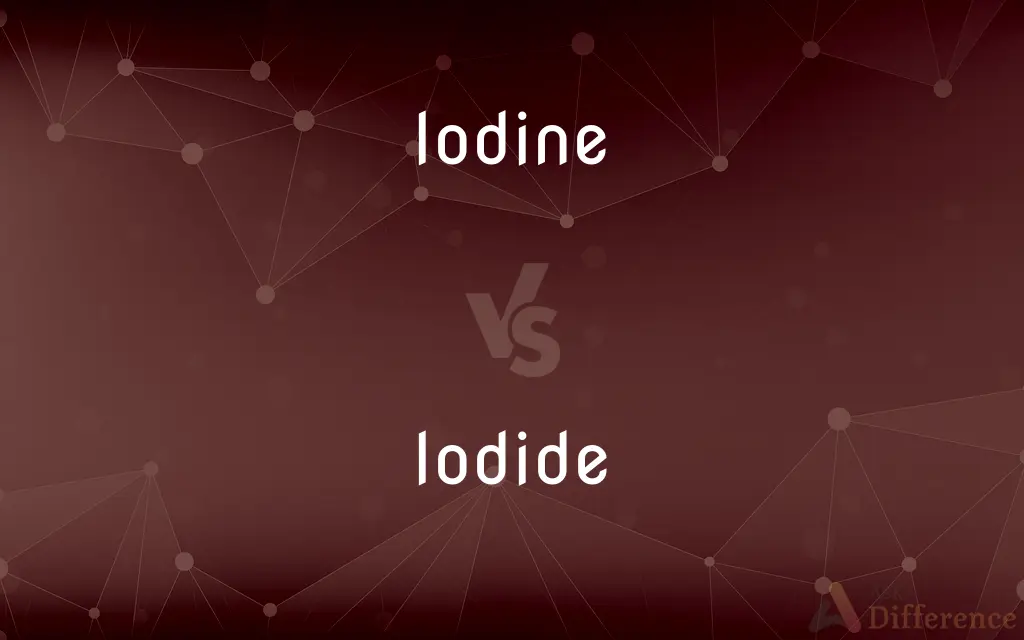Iodine vs. Iodide — What's the Difference?
By Fiza Rafique & Maham Liaqat — Updated on March 14, 2024
Iodine is a chemical element, while iodide is its anion form, bearing a negative charge.

Difference Between Iodine and Iodide
Table of Contents
ADVERTISEMENT
Key Differences
Iodine, denoted by the symbol I and atomic number 53 on the periodic table, is a halogen element known for its purplish-black crystalline solid form at room temperature. Iodide, on the other hand, is the ion form of iodine, represented as I⁻, occurring when iodine gains an electron, thus carrying a negative charge.
In its elemental form, iodine is less soluble in water but can dissolve in organic solvents or through the formation of iodine solutions with iodides, such as potassium iodide. Iodide ions, being more reactive chemically, readily form salts with metals and are often used in iodized salt to prevent iodine deficiency.
Iodine is essential for thyroid function in humans, contributing to the synthesis of thyroid hormones. Iodide, as the more bioavailable form of iodine, is utilized by the thyroid gland to produce these necessary hormones, highlighting the biological importance of the ionized form.
The antiseptic properties of iodine are well-known, especially in tincture form, which is used for disinfecting wounds. Iodide salts, while also having medical applications, are typically employed in a different context, such as in radiography and as nutritional supplements.
Environmental sources of iodine vary, with iodine occurring naturally in soils and seawater, leading to its presence in certain foods. Iodide ions are more commonly encountered in the human diet, particularly in iodized table salt, which is fortified to address dietary iodine deficiencies.
ADVERTISEMENT
Comparison Chart
Form
Elemental, purplish-black crystals
Anion with a negative charge
Solubility
Low in water, dissolves in organic solvents
Highly soluble, forms salts
Biological Role
Essential for thyroid function
Utilized by the thyroid, more bioavailable
Applications
Antiseptics, disinfectants
Nutritional supplements, radiography
Source
Naturally in soils, seawater
Iodized salt, dietary sources
Compare with Definitions
Iodine
Elemental form.
Iodine is visible as purplish-black crystals.
Iodide
Ion form.
Iodide ions are formed when iodine gains an electron.
Iodine
Found in nature.
Iodine occurs naturally in seawater and soil.
Iodide
Highly soluble.
Iodide forms soluble salts with metals.
Iodine
Less soluble in water.
Iodine's solubility increases in the presence of iodides.
Iodide
Used in radiography.
Iodide salts are contrast agents in medical imaging.
Iodine
Essential for health.
Iodine is crucial for producing thyroid hormones.
Iodide
Added to salt.
Table salt is often iodized with iodide to prevent deficiency.
Iodine
Used as an antiseptic.
Tincture of iodine is applied to disinfect wounds.
Iodide
Bioavailable for the thyroid.
The thyroid gland uses iodide to synthesize hormones.
Iodine
Iodine is a chemical element with the symbol I and atomic number 53. The heaviest of the stable halogens, it exists as a semi-lustrous, non-metallic solid at standard conditions that melts to form a deep violet liquid at 114 degrees Celsius, and boils to a violet gas at 184 degrees Celsius.
Iodide
An iodide ion is the ion I−. Compounds with iodine in formal oxidation state −1 are called iodides.
Iodine
Symbol I A lustrous, purple-black, corrosive, poisonous halogen occurring as a diatomic molecule, I2, that easily sublimes to give a purple gas and is a trace element essential for proper thyroid function. Radioactive isotopes, especially I-131, are used as medical tracers and in thyroid disease diagnosis and therapy. Iodine compounds are used as germicides, antiseptics, and dyes. Atomic number 53; atomic weight 126.9045; melting point 113.7°C; boiling point 184.4°C; density of gas 11.27 grams per liter; specific gravity (solid, at 20°C) 4.93; valence 1, 3, 5, 7. See Periodic Table.
Iodide
Univalent anionic iodine, or a compound of iodine, especially a binary compound of iodine with a more electropositive element.
Iodine
An antiseptic preparation containing iodine in solution, used to treat wounds.
Iodide
(inorganic chemistry) A binary compound of iodine and another element or radical.
Iodine
A chemical element (symbol: I) with an atomic number of 53; one of the halogens.
Iodide
A binary compound of iodine, or one which may be regarded as binary, in which iodine has a valence of -1; as, potassium iodide.
Iodine
An antiseptic incorporating the element.
Iodide
A salt or ester of hydriodic acid
Iodine
An iodide.
Iodine
(transitive) to treat with iodine.
Iodine
A nonmetallic element, of the halogen group of atomic number 53, occurring always in combination, as in the iodides. When isolated it is in the form of dark gray metallic scales, resembling plumbago, soft but brittle, and emitting a chlorinelike odor. Symbol I. Atomic weight 126.90. If heated, iodine volatilizes in beautiful violet vapors.
Iodine
A nonmetallic element belonging to the halogens; used especially in medicine and photography and in dyes; occurs naturally only in combination in small quantities (as in sea water or rocks)
Iodine
A tincture consisting of a solution of iodine in ethyl alcohol; applied topically to wounds as an antiseptic
Common Curiosities
What is iodine?
Iodine is a chemical element, essential for thyroid function and known for its antiseptic properties.
What is iodide?
Iodide is the ionized form of iodine, carrying a negative charge and used by the thyroid gland.
How do iodine and iodide differ in solubility?
Iodine is less soluble in water but soluble in organic solvents, while iodide forms highly soluble salts.
What are iodide salts used for?
Iodide salts are used in nutritional supplements, radiography, and as a fortification in iodized salt.
Can the body use elemental iodine?
The body primarily uses the iodide form for thyroid function, though iodine can be metabolized to iodide.
Why is iodine added to table salt?
Iodine, in the form of iodide, is added to salt to prevent iodine deficiency in the diet.
Can iodine and iodide be used interchangeably in medical treatments?
Their applications differ; iodine is used topically as an antiseptic, while iodide has specific uses in nutrition and radiography.
What are the uses of iodine?
Iodine is used as an antiseptic, in disinfectants, and is crucial for thyroid hormone synthesis.
How are iodine and iodide obtained from the environment?
Iodine is naturally present in soils and seawater, while iodide is commonly found in dietary sources, especially iodized salt.
Are there any risks associated with excessive iodine or iodide intake?
Excessive intake can lead to thyroid dysfunction, underscoring the need for balanced consumption.
Is iodized salt the only dietary source of iodide?
No, iodide is also naturally present in fish, dairy products, and some grains.
What happens to iodine when it enters the body?
Iodine is converted to iodide in the body, which is then used by the thyroid gland.
What is the role of iodine in the thyroid?
Iodine is essential for the synthesis of thyroid hormones, which regulate metabolism.
How does iodide support thyroid health?
Iodide is the form the thyroid gland uses to produce vital hormones.
Why is iodine important in a diet?
Iodine is crucial for healthy thyroid function, impacting metabolism, growth, and development.
Share Your Discovery

Previous Comparison
Submit vs. Submitted
Next Comparison
Beer vs. LiquorAuthor Spotlight
Written by
Fiza RafiqueFiza Rafique is a skilled content writer at AskDifference.com, where she meticulously refines and enhances written pieces. Drawing from her vast editorial expertise, Fiza ensures clarity, accuracy, and precision in every article. Passionate about language, she continually seeks to elevate the quality of content for readers worldwide.
Co-written by
Maham Liaqat













































